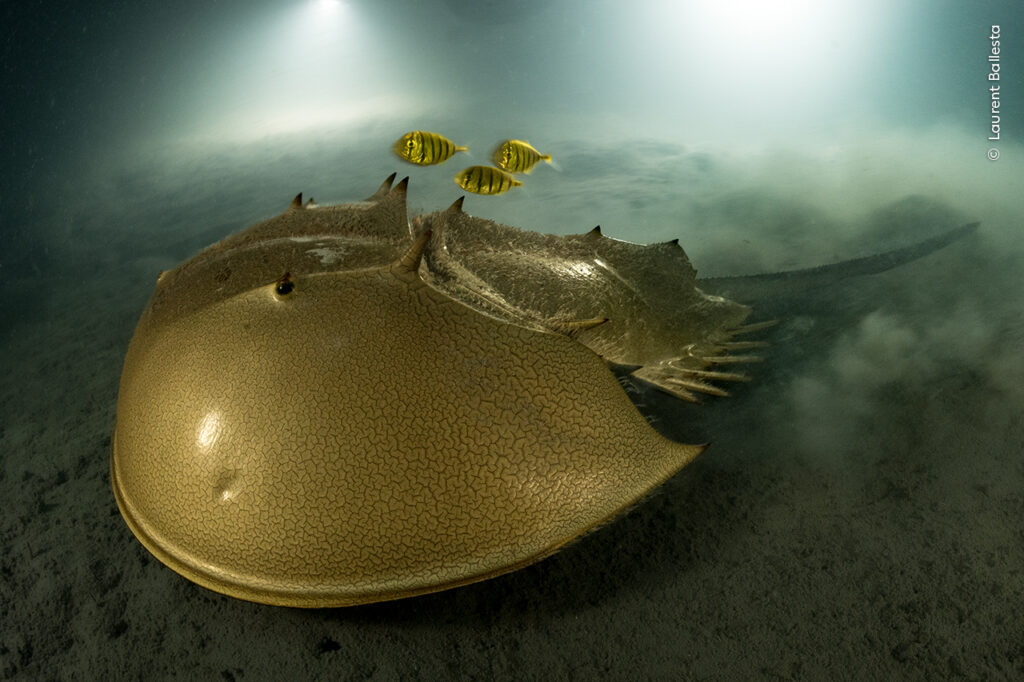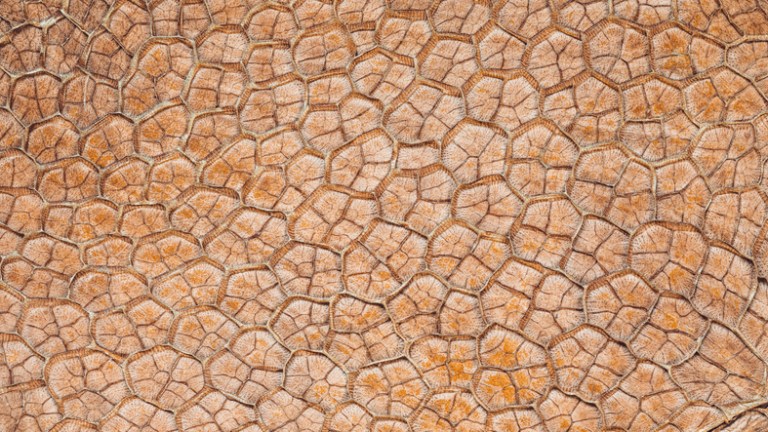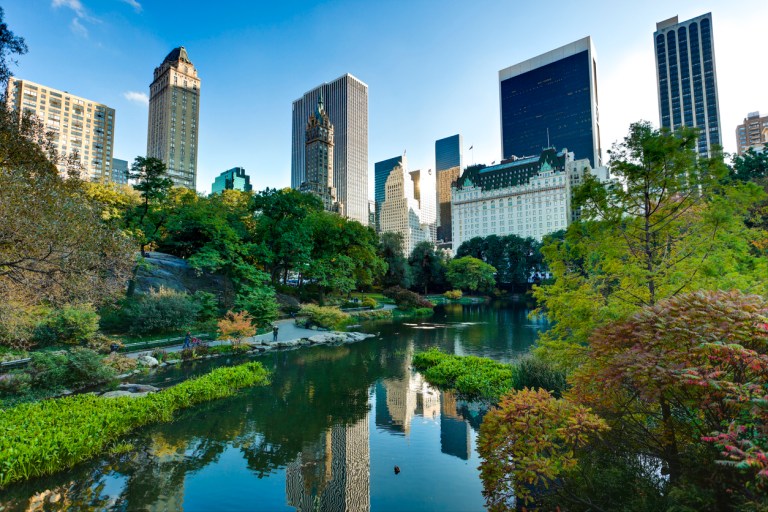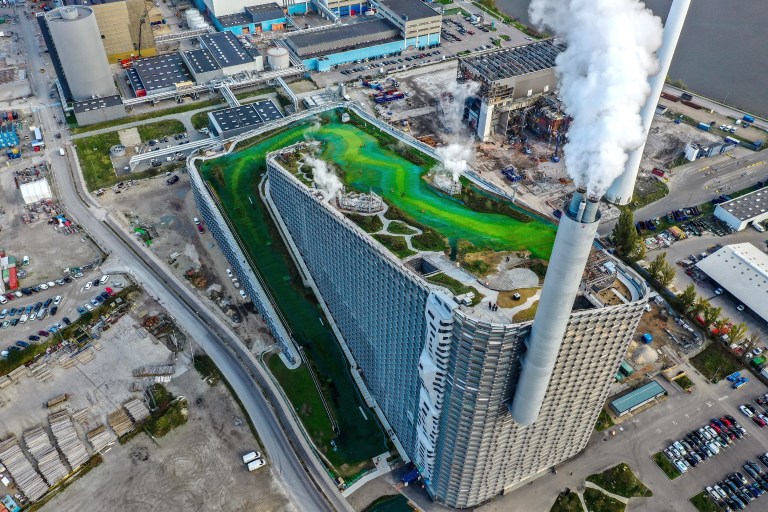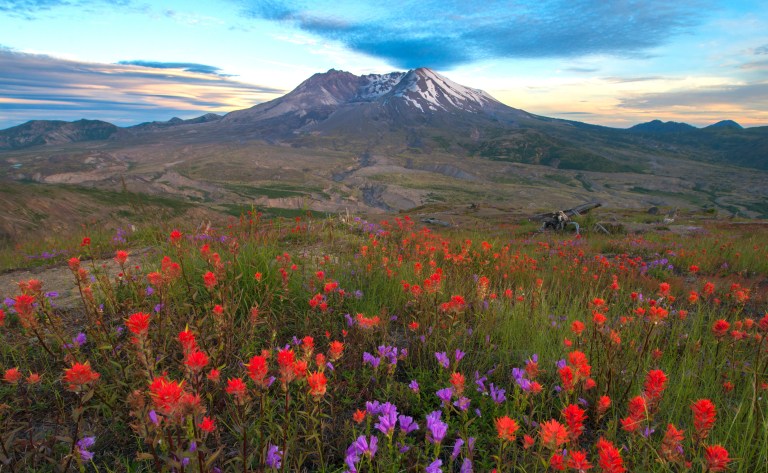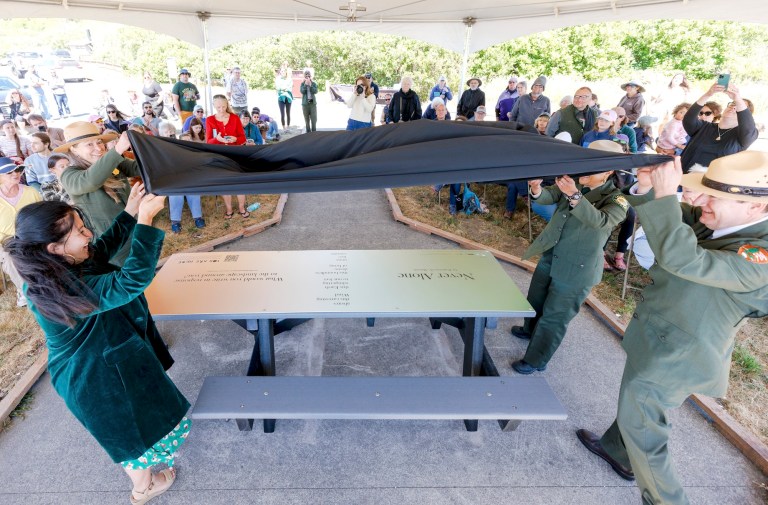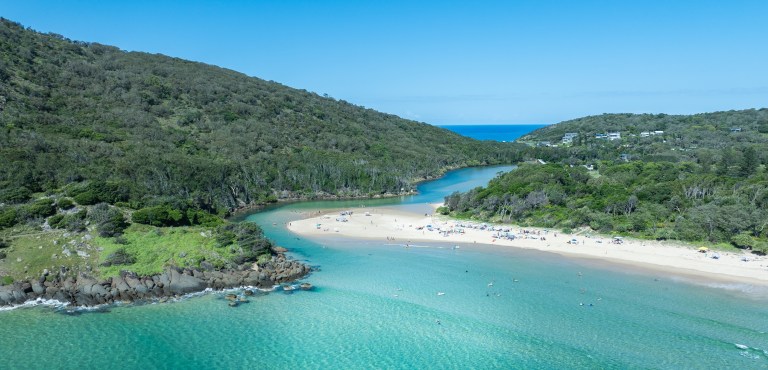The results are in for the 2023 Wildlife Photographer of the Year awards — and the competition was stiff. Judges whittled down a whopping 49,957 entries from 95 countries to select 19 category winners. They include an underwater image of a mother hippopotamus and her young in South Africa, a mystical shot of a fungus releasing its spores in Greece, a forest illuminated with fireflies in India, and more.
French photographer and marine biologist Laurent Ballesta was named Wildlife Photographer of the Year for his photo of a tri-spine horseshoe crab accompanied by three golden trevally fish. Titled “The golden horseshoe,” the radiant shot showcases the resilience of a species that has survived for over 100 million years but currently faces extinction due to habitat loss and overfishing.
“To see a horseshoe crab so vibrantly alive in its natural habitat, in such a hauntingly beautiful way, was astonishing,” jury chair and editor Kathy Moran said in a statement. “We are looking at an ancient species, highly endangered, and also critical to human health. This photo is luminescent.”
Ballesta, 49, is only the second photographer in the competition’s 59-year history to earn the honor twice — his captivating photo of camouflage groupers spawning under a full moon took the top spot in 2021. He was also recognized in last year’s contest, winning the portfolio prize for a collection of images revealing a rich array of life under ice shelves in the Antarctic ocean.
"Owls’ road house" by Carmel Bechler, Israel — Winner, 15-17 Years and Young Wildlife Photographer of the Year
Carmel Bechler / Wildlife Photographer of the Year
In an effort to foster young talent, the competition includes multiple categories for photographers under 18 and also awards a second grand title: The Young Wildlife Photographer of the Year. The 2023 honor went to 17-year-old Carmel Bechler from Israel for “Owls’ road house,” an electric image of barn owls perched in the window of an abandoned building. The teen hid behind his family’s car to steal the shot, using long exposure times to capture the trails of light and color from passing headlights.
“I hope to share with my photography that the beauty of the natural world is all around us, even in places where we least expect it to be, we just need to open our eyes and our minds,” said Belcher, who has been training his camera on wildlife since age 11.
“This photograph has so many layers in terms of content and composition,” Moran commented. “It simultaneously screams ‘habitat destruction’ and ‘adaptation,’ begging the question: If wildlife can adapt to our environment, why can’t we respect theirs?”
Wildlife Photographer of the Year is developed and produced by the Natural History Museum, London, where the 2023 honored photos will be displayed through June.
“Whilst inspiring absolute awe and wonder, this year’s winning images present compelling evidence of our impact on nature — both positive and negative,” museum director Doug Gurr commented. “Global promises must shift to action to turn the tide on nature’s decline.”
Entries for next year’s competition will open Oct. 16, and photographers of all ages, skill levels, and nationalities are encouraged to submit.
Scroll down to check out more of the winning images.
“Hippo nursery” by Mike Korostelev, Russia — Winner, Underwater
"Mike Korostelev reveals a hippopotamus and her two offspring resting in the shallow clear-water lake. For over two years Mike has been visiting the hippos in this lake and knew they were accustomed to his boat. He spent just 20 seconds under water with them — enough time to get this image from a safe distance and to avoid alarming the mother. Hippos produce one calf every two to three years. Their slow-growing population is particularly vulnerable to habitat degradation, drought, and illegal hunting for meat and ivory from their teeth."
Mike Korostelev / Wildlife Photographer of the Year
“Lights fantastic” by Sriram Murali, India — Winner, Behaviour: Invertebrates
"Sriram Murali showcases a night sky and a forest illuminated with fireflies. Sriram combined fifty 19-second exposures to show the firefly flashes produced over 16 minutes in the forests near his hometown. The firefly flashes start at twilight, with just a few, before the frequency increases and they pulse in unison like a wave across the forest. Fireflies, which are in fact beetles, are famous for attracting mates using bioluminescence. Darkness is a necessary ingredient in the success of this process. Light pollution affects many nocturnal creatures, but fireflies are especially susceptible."
Sriram Murali / Wildlife Photographer of the Year
“The wall of wonder” by Vihaan Talya Vikas, India — Winner, 10 Years and Under
"Vihaan Talya Vikas watches as an ornamental tree trunk spider prevents its prey from escaping. This was Vihaan’s first visit to the tamarind grove. Fascinated by stories of the Hindu god Krishna, it seemed to Vihaan as if the spider had positioned its web after being entranced by the sound of Krishna’s flute. This spider is an orb weaver, which creates a wheel-shaped web of sticky threads to catch flying insects. As the spider grows, it elongates its web, which entangles anything that lands on it."
Vihaan Talya Vikas / Wildlife Photographer of the Year
“The art of courtship” by Rachel Bigsby, U.K. — Winner, Natural Artistry
"Rachel Bigsby frames a gannet pair against the guano-painted curves of sandstone cliffs. From her boat in turbulent sea swell, Rachel realized that achieving her vision of showcasing gannets set against the towering cliffs would be tricky. But as the boat aligned with the rocks, she spotted this pair ‘isolated on a lower ledge, intertwining their necks and framed by streaks of guano’. Each summer the Isle of Noss hosts more than 22,000 northern gannets, which return to breed on the ledges carved by the elements. This species was hardest hit by the 2022 avian flu outbreak."
Rachel Bigsby / Wildlife Photographer of the Year
“Last breath of autumn” by Agorastos Papatsanis, Greece — Winner, Plants and Fungi
"Agorastos Papatsanis reveals the magic of a fungus releasing its spores in the forest. Long fascinated by fungi, Agorastos used his silver photographic umbrella to stop his camera getting wet, and covered his carefully positioned flash with a plastic bag. The colorful touches come from refraction of the light passing through the spore-laden air currents and rain. Parasol mushrooms release spores from the gills under their cap. Billions of tiny spores travel — usually unseen — in the air currents. Some will land where there is moisture and food, enabling them to grow networks under the forest floor."
Agorastos Papatsanis / Wildlife Photographer of the Year
“Birds of the midnight sun” by Knut-Sverre Horn, Norway — Winner, Urban Wildlife
"Knut-Sverre Horn offers a glimpse of kittiwake chicks illuminated in an abandoned factory. From his vantage point inside an abandoned fish-processing factory, Knut-Sverre kept watch on the black-legged kittiwakes tending to their chicks on the windowsill. As midnight approached, the low summer sun struck the north-facing window, sharpening the birds’ silhouettes and giving him the image that he wanted. Kittiwakes naturally nest on the narrow ledges of high, steep coastal cliffs. Recently numbers have plummeted, and some have headed for urban areas due to shortages of food caused by warming oceans and pollution."
Knut Sverre Horn / Wildlife Photographer of the Year
“Life on the edge” by Amit Eshel, Israel — Winner, Animals in their Environment
"Amit Eshel witnesses a dramatic cliffside clash between two Nubian ibex. After hiking to a vantage point on the clifftop, Amit slowly crept closer, using a wide-angle lens to set the action of two clashing Nubian ibex against the dramatic backdrop. The battle lasted for about 15 minutes before one male surrendered, and the pair parted without serious injury. In the run-up to the mating season, part of the males’ coat darkens, and their neck muscles thicken. Rivals will raise up on their hind legs and ram their heads together. Their horns sometimes break as they collide."
Amit Eshel / Wildlife Photographer of the Year
“Out of the blue” by Ekaterina Bee, Italy — Winner, 11-14 Years
"Ekaterina Bee shares her intimate encounter with some common bottlenose dolphins. Ekaterina’s trip to the west coast of Scotland was filled with wildlife encounters, but bottlenose dolphins were an unexpected surprise. From the boat she composed this image, which highlights the surface patterns on the water created by the dolphins’ movements. Common bottlenose dolphins can be found throughout the world’s oceans except in polar regions. Living in small groups, they are highly social animals, and are one of the top marine predators living in Scottish waters."
Ekaterina Bee / Wildlife Photographer of the Year
“Face of the forest” by Vishnu Gopal, India — Winner, Animal Portraits
"Vishnu Gopal records the moment a lowland tapir steps cautiously out of the swampy Brazilian rainforest. Finding hoofprints on a forest track near his campsite, Vishnu waited nearby. An hour later, the tapir appeared. Using a long exposure and torchlight to capture texture and movement, Vishnu framed the tapir’s side-turned head as it emerged from the forest. Lowland tapirs rely on the forest for their diet of fruit and other vegetation and in turn the tapirs act as seed dispersers. This important relationship is threatened by habitat loss, illegal hunting and traffic collisions."
Vishnu Gopal / Wildlife Photographer of the Year
“The tourism bulldozer” by Fernando Constantino Martínez Belmar, Mexico — Winner, Photojournalist
"Fernando Constantino Martínez Belmar shows the devastating path of a new cross-country tourist railway line. To reach a point from where he could launch his drone, Fernando was guided through four kilometres (2.5 miles) of an underground cave system. The result of his challenging trek was this image. The government-funded railway line connecting tourist destinations brings economic benefits to Mexico’s southeast, but it also fragments ecosystems, threatens protected reserves and archaeological sites, and impacts Indigenous peoples. While trains are a more environmentally friendly form of transport, conservationists warn of devastating consequences."
Fernando Constantino Martínez Belmar / Wildlife Photographer of the Year
“Silence for the snake show” by Hadrien Lalagüe, France — Winner, Behaviour: Birds
"Hadrien Lalagüe is rewarded for his patience with a perfect alignment of grey-winged trumpeters watching a boa slither past. Hadrien set up his camera trap by a track in the rainforest surrounding Guiana Space Center. He spent the next six months maintaining the camera kit against high humidity, plastic-munching ants and damage by poachers. This image was his reward. Trumpeters — named for their loud calls — spend most of their time foraging on the forest floor, eating ripe fruits, insects and the occasional small snake. The boa constrictor, more than three meters (9.8 feet) long, could have made a meal of them."
Hadrien Lalagüe / Wildlife Photographer of the Year
“The dead river” by Joan de la Malla, Spain — Winner, Wetlands
"Joan de la Malla provides a bird’s-eye view of the polluted Ciliwung river winding through Indonesia’s capital, Jakarta. To find a time when lower air pollution allowed a clear view, Joan returned to the scene over several days. His image documents one of the most polluted rivers in the world and illustrates the growing global issue of river pollution. Plastic rubbish, human waste, agricultural fertilizers and factory waste are suffocating the Ciliwung river. As a result, Jakarta’s residents are having to use groundwater for drinking water. This has resulted in widespread subsidence and the city is now sinking."
Joan de la Malla / Wildlife Photographer of the Year
‘The ice ibex’ by Luca Melcarne, France — Winner, Rising Star Portfolio Award
"Luca Melcarne makes the most of his mountain-guide skills to reveal the fascinating lives of Alpine animals. Born at the foot of the Vercors mountains in France, Luca is a professional mountain guide and nature photographer. He is addicted to the cold, constantly watching the weather to make his plans. His portfolio highlights the animals that live in the Vercors Regional Natural Park, where Luca lives and works. His remarkable images demonstrate how patience, perseverance and passion are essential ingredients for dramatic wildlife photography. To enable an early ascent into ibex territory, Luca had spent a bitterly cold night in a temporary shelter in the French Alps, having skied for six hours across the natural park. Luca thawed his camera with his breath and took the ibex’s portrait."
Luca Melcarne / Wildlife Photographer of the Year














